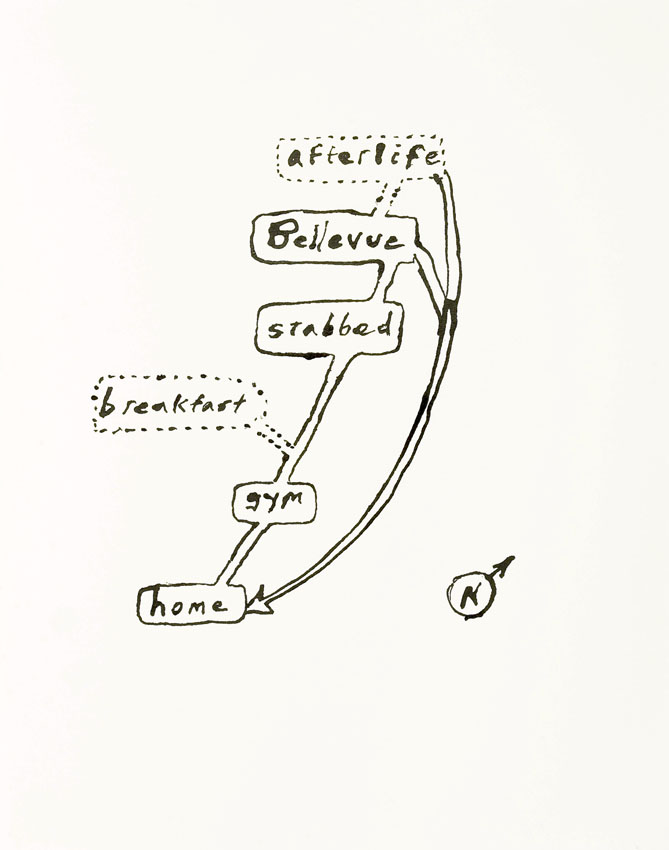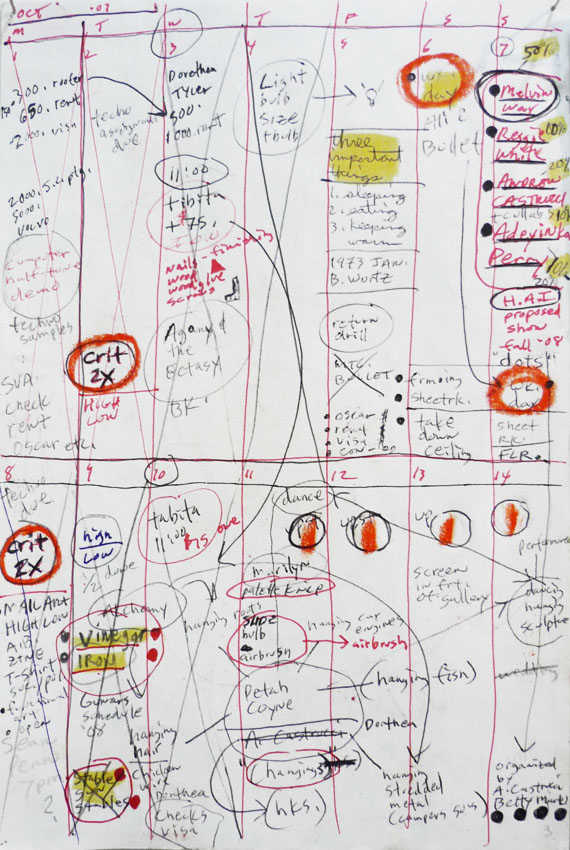A Gathering of the Tribes: NOTE TO SELF: ON THE EXHIBITION “AND ONE MORE THING”
When does dawn occur: when the first bird makes itself heard; when the sun rises above the horizon? Or when the lights of the Empire State Building are turned off? While a wry humor underlies many of Walter Sipser’s drawings, this effort to pinpoint what is essentially amorphous becomes a poignant conceit that carries throughout the exhibition “One More Thing” at Bullet Space.

“Untitled” by Melvin Way, 2001. Ink on paper, 3″ x 9″

“Plan B” by Walter Sipser, 2009. Ink on paper, 11″ x 14″
From “2555 Days” by Andrew Castrucci , 2003-2010. Pen, pencil on paper, 6″ x 9″
The works of the four artists Andrew Castrucci, David Hammons, Walter Sipser, and Melvin Way share an ambiguous relationship to the present tense. Contingency replaces causality as the dominant mode of perception; external phenomena are painstakingly recorded in an effort to make sense of the nonsensical and to find meaning in the arbitrary.
Sipser’s drawings reveal a brilliant, preposterous logic. His detailed and numbered diagrams, inventions, and prosthetic devices recall, in their poetic absurdity, the pseudophilosophical movement of Jarry’s pataphysics and offer a glimpse into the inquiring mind as it seeks to evade the aporia of its own existence. In “Note to Self,” a To Do list consisting of nothing but these same three words is drawn in the manner of an elaborate, time-killing doodle; in another drawing we are “Lost at Sea,” with the words of the title looming large on the page in a kind of mental haze consisting of small ink marks that look like imperfect mechanical copies rather than originals. While the humor in Sipser’s work belies a disquiet with the dumb fact of being, his drawings often allude to an underlying order of things in an allover of superimposed shapes drawn in dotted lines and resembling a cross between cookie-cutter and typographic glyph—evoking notions of normative roles, uncertain identities, and individual aberration. Some of the drawings consist of single letters drawn in a sans-serif font and enclosed in a circle; isolated from their alphabetical context and transformed into cryptic symbols, they become drained of meaning in an unexpected inversion of the utterly familiar that contrasts with the black silhouettes of composite shapes in other drawings. While Sipser seems to be saying that the solipsistic mind arrives at erroneous conclusions, and he has some of his drawings notarized as though in an effort to find objective proof of his own existence, the artistic outcome is nothing short of amazing. Yet when we learn that his map-like drawing “Plan B,” which depicts an inky path from home to gym to breakfast, is based on a real-life occurrence, the stakes suddenly become very high: the word “breakfast” is written in dotted lines as the path is redirected to the words “stabbed” and subsequently to “Bellevue,” narrowly escaping the “afterlife” in dotted lines at the top of the page.
Andrew Castrucci’s visual approach to the ineluctable fabric of existence presents us with the notated evidence of the everyday. Seven years of date book pages—“2555 Days”—are arranged in a grid on the wall. In an apparent effort to keep track of various subcategories of obligation in a concatenation of overlapping dates, times, places, and things that need to be done, Castrucci color coded many of his entries, producing what are essentially filigree word drawings in black, red, and yellow.
The shorthand of an artist’s and art instructor’s life: SVA classes, rent calculations, studio visits, student critiques; building materials to be purchased, framers to be paid, video edits to be scheduled; endless lists of make-up classes, portfolio reviews, application deadlines, Fed-Ex shipments. Tax due-dates. And again and again, “Call Goshen, call Goshen, call Goshen.”
Castrucci’s decision, after the fact, to classify these pages as art is a revealing act, one that emphasizes the process and reconfigures notions of purpose, statement, and the “finished work.” The art in this case is the sediment of life lived in real time: the tracks in the mud, the remains adhering to the inside of the coffee cup—an accrual that is the diametric inversion of Hanne Darboven’s scrawled notations representing a calendar time that bears no direct relation to the actual process of making the work.
Oddly, an entry on November 14, 2007—“Whitney, Kara Walker”—led me to recall that this was a day I’d also visited the exhibition on one of my trips to New York—and run into Andrew outside, in front of the African masks. I had my niece with me at the time, there were urgent things to talk about, and so all I could do was say Hi—and can we get together next time? Contingencies, serendipity, and my own life looping back on itself somehow, peculiarly ensconced within Castrucci’s quotidian diagrams. And emerging from these skeins of purpose an occasional cry: “Three Important Things: Sleeping, Eating, Keeping Warm.” “Protein, Vitamin C, Meat.” And then, on November 17, the utterly improbable juxtaposition of the words “Shakespeare” and “Wet suit,” connected by an arrow. Castrucci’s work has the somber hilarity of the Readymade, a Duchampian quality that shifts the emphasis away from the work of art to the receptive, reflective state of mind.
Of which state David Hammons is a master. Standing between street vendors for his now-famous 1983 performance at Cooper Square in New York, “Bliz-aard Ball Sale,” Hammons offered neatly sculpted snowballs for sale, arranged, amusingly, according to size. The work demonstrated two things: that anything can be commercialized, given the right context; and, less profanely, that anything can be perceived as art, given a commensurately receptive state of mind.
Hammon’s piece at Bullet Space questions the idea of artistic authorship. The original work it is based on, “Global Fax Festival,” was shown ten years ago at the Palacio de Cristal del Retiro in Madrid. Five fax machines were secured to the ceiling, actively transmitting faxes of drawings sent from around the world, which curled, broke off like falling leaves, and twirled to the ground. In New York City, A Gathering of the Tribes became the main source location for sending over 3,000 faxes during a live musical performance by Butch Morris and subsequently throughout the rest of the exhibition’s duration. Hammon’s work at Bullet Space consists of a video of this piece accompanied by a selection of photocopies of the original faxed drawings scattered about the floor, artifacts of a work made by friends and strangers all over the world, crystallizing in a single location like an intersection of fleeting trajectories.
Melvin Way was discovered by Andrew Castrucci in a drawing workshop Castrucci taught at a men’s shelter on Ward’s Island in 1989. Over the following years, although Way’s mental health problems led him to a series of different shelters around the city, he and Castrucci remained friends. Way’s idiosyncratic notations—scrawled in ballpoint pen on paper and cardboard in an encyclopedic accumulation of obsessive abbreviations—consist of chemical, molecular, mathematical, and metaphysical formulas hinting at an alchemy of the troubled soul. Occasionally, he inserts words: “Soft Soap, Gum Shoe, Sleuth … Intrigue, Espionage, Sabotage, Comedy.” Or: “Homicide, Suicide, Effect … Defect, Adaptation, Eradication.” Although the works come across as tirades, there is a cool sense of control, sophistication, even indifference. Here too, the question arises as to the nature of the deliberate artistic act—as in the works of Sipser, Castrucci, and Hammons, we are looking at another category of urgency altogether. The artist is more than anything else a human being, and the artistic gesture an act of resistance against the unknowable, death, and being.
“And One More Thing” Bullet Space 292 East 3rd Street New York, NY 10009 Hours: Fri 3–6 p.m.; Sat/Sun 1–6 p.m. or by appointment. Tel.: 347 277 9842
Andrea Scrima is an artist and author; her first book, “A Lesser Day,” has just come out with Spuyten Duyvil Press.


an urban artists collab. ———————————- REN 162 + Rojas + Way + Sipser + Castrucci